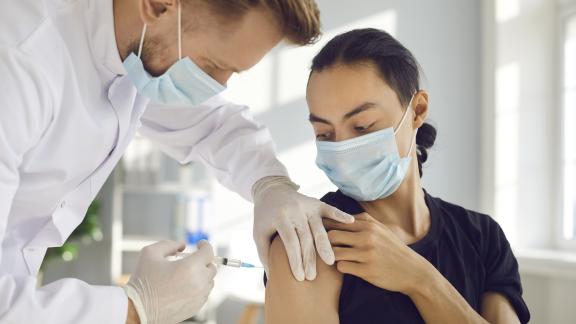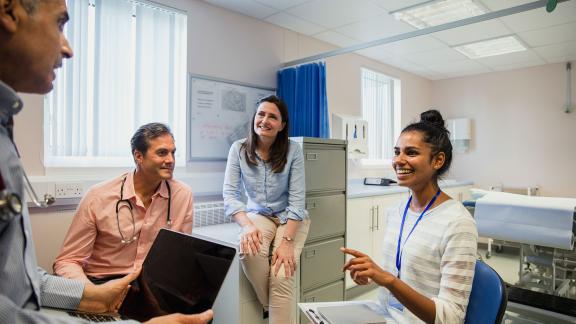Cambridgeshire and Peterborough ICS: Access and Inequalities Nurse Project

Cambridgeshire and Peterborough ICS is in its second year of supporting vaccination uptake improvement through its centrally-funded Access and Inequalities Nurse Project.
Overview
Cambridgeshire and Peterborough ICS is now entering its second year of supporting vaccination uptake improvement by providing centrally-funded nursing capacity, through the Access and Inequalities Nurse Project, to practices with low uptake.
Outcomes
- 6,000 additional doses delivered.
- 4 per cent improvement in uptake in quarter 1 of 2025-26.
- New clinics introduced to meet the needs of immunosuppressed patients and those with sensory needs.
What the system faced
Vaccination uptake has declined across the country for certain childhood and adult vaccinations. Throughout the Cambridgeshire and Peterborough system, practices had significant variation in uptake and capacity. The MMR and COVID-19 vaccinations were key areas of concern due to rising infections.
What the system did
In 2023 the integrated vaccination service programme lead began looking into vaccination uptake across the system. Initially, practices across the system were encouraged to conduct data cleansing and identify ghost patients to improve data quality. The ICS vaccination team was then able to use the improved data, supplied by the Child Health Information Service, to target support to practices which had a low uptake of MMR and COVID-19 vaccines. Further support to improve data quality was then included in the Access and Inequalities Nurse Project (A+I).
The A+I project was fully funded by the ICS vaccination team from the access and inequalities funding allocated to ICBs from NHS England. Hertfordshire Community Trust was commissioned to be the lead provider.
The ICS investigated the existing practice capacities, and the status of out-of-hours provision. The ICS then commissioned Hertfordshire Community Trust to lead and reach out to practices and vulnerable groups including those in asylum hotels and Gypsy, Roma, Traveller communities. Providers were assessed and prioritised based on need and initially the seven practices with lowest uptake were selected to participate in the A+I project. The programme centrally funds additional nurses to go to practices and deliver a range of support to improve uptake. The nurses:
- deliver vaccines – the MMR and COVID-19 vaccines are prioritised, but nurses can deliver any additional vaccines
- conduct data cleansing
- administer home visit vaccinations
- provide vaccine information to patients
- organise and arrange engagement events in low uptake communities.
Each practice determines the service they need from the A+I nurses to best meet their local need. Any practice can also request additional capacity to support with events where opportunistic vaccination could occur, but practices with highest levels of need are prioritised.
Beyond practices, through close working with local authorities, the A+I service now provides vaccination support at a range of events and locations including:
- faith settings including mosques
- town halls
- fetes
- pride
- university freshers’ week
- family hubs
- football and cricket grounds.
Challenges
Capacity: There are 85 practices in the system, but the team is only able to work with around ten at a time. For life-course vaccinations, this process makes a lasting improvement on vaccination rates, but for seasonal vaccinations, practices may need recurring support.
Funding: The project is fully funded by the ICS and NHS England and has been renewed until June 2026. However, staff are uncertain how the changing ICS landscape will impact the project. The team hopes to expand the project across a larger footprint once the commissioning landscape has stabilised.
Buy in from practices: Not every practice welcomed the opportunity to be part of the project. For some, small populations have a disproportionate impact on their data and so it’s not necessary to send in additional capacity. In others, concerns around workload can impact the decision. Where there is resistance, the team opens a dialogue with practices and reiterate that they provide the nurses’ time and expertise for free, which influences more practices to join the programme.
Communications: A lack of national messaging and communications resources has impacted patient awareness, and in some cases their ability to access information. The team has produced a range of materials to promote vaccine services, including multi-lingual resources for patients with English as a second language. The team also redesigned the ICS vaccinator website to make it easier for patients to navigate and understand the service.
Key learning
Access is as significant a barrier as hesitancy: Across the system, high numbers of working people are on zero-hours contracts and need access outside of regular working hours. The team addressed this need by prioritising evening and weekend appointments with capacity for walk ins, as this was the preferred access type. The team also focus on small, local venues to reduce travel need, and have seen more success in a ‘little and often’ approach than in large sites.
Trust is improved by local connectors: During the COVID-19 pandemic, patients trusted community members who could speak confidently on vaccine efficacy and how to access the service. These connectors have been lost due to shift in priorities post-pandemic.
Cross-sector collaboration: Collaborating with a wide range of partners, including local authority public health teams and local providers, is an effective way to build long-term relationships which may benefit future working beyond vaccination, and to pool resources and experience to make a more significant impact than one organisation could alone.
This page forms part of a collection of case studies and resources on our vaccination hub, produced in partnership with ABPI.



